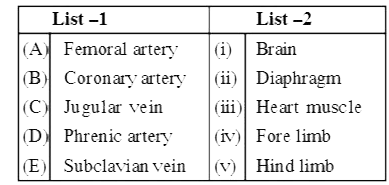Match the following. List 1 Treponema pallidum Yersinia pestis Bacillus anthracis Vibrio List 2 Plague Anthrax Syphilis Cholera
The correct Answer is:A
To match the organisms in List 1 with their corresponding diseases in List 2, we can follow these steps:
1. Identify Treponema pallidum:
- Treponema pallidum is a type of bacteria known to cause syphilis, which is a sexually transmitted infection.
- Match: Treponema pallidum → Syphilis
2. Identify Yersinia pestis:
- Yersinia pestis is a gram-negative bacterium responsible for causing the plague, which is a severe infectious disease.
- Match: Yersinia pestis → Plague
3. Identify Bacillus anthracis:
- Bacillus anthracis is a gram-positive, spore-forming bacterium that causes anthrax, a serious infectious disease.
- Match: Bacillus anthracis → Anthrax
4. Identify Vibrio:
- Vibrio is a genus of bacteria that includes species responsible for cholera, an infectious disease characterized by severe diarrhea.
- Match: Vibrio → Cholera
Final Matches:
- Treponema pallidum → Syphilis
- Yersinia pestis → Plague
- Bacillus anthracis → Anthrax
- Vibrio → Cholera
- Treponema pallidum is a type of bacteria known to cause syphilis, which is a sexually transmitted infection.
- Match: Treponema pallidum → Syphilis
- Yersinia pestis is a gram-negative bacterium responsible for causing the plague, which is a severe infectious disease.
- Match: Yersinia pestis → Plague
- Bacillus anthracis is a gram-positive, spore-forming bacterium that causes anthrax, a serious infectious disease.
- Match: Bacillus anthracis → Anthrax
- Vibrio is a genus of bacteria that includes species responsible for cholera, an infectious disease characterized by severe diarrhea.
- Match: Vibrio → Cholera
- Treponema pallidum → Syphilis
- Yersinia pestis → Plague
- Bacillus anthracis → Anthrax
- Vibrio → Cholera
Topper's Solved these Questions
Similar Questions
Match the columns and find out the correct combination
Column IColumnIIaTreponema(i)PlaguebYersinia pestis(ii)AnthraxcBacillus anthracis(iii)SyphilisdVibro(iv)Cholera
View SolutionMatch the items of Column I with the appropriate items of Column II. List 1 Amoebiasis Diphtheria Cholera Syphilis List 2 Treponema pallidum Use only sterilized food and water DPT Vaccine Use oral rehydration
View Solution
Knowledge Check
Which of the following lists those integer value of D for which the fraction 2D lies between 15and13?
A4 onlyB3,4 and 5C8 onlyD7, 8, and 9Match column I with column II and select he correct option from codes given below.
Column IColumn IIAmoebiasis (i)Treponema pallidumDiphtheria(ii)Houseflies as mechanical carriersCholera(iii)DPT vaccineSyphilis(iv)Oral rehydration therapyAABCDiiiiiiivBABCDiiiiiiviCABCDIiiiiiivDABCDiiivIiii
Match the following lists :
List 1 List 2
Property to be determined Method used for determination
( A ) Molecular mass of a volatile oragnic solid 1. Silver salt method
(B ) Molecular mass of anon-volatile organic solid 2. Liebig method
( C ) Estimation of chlorine in carbon tetrachloride 3. Platinichloride method
( D ) Estimation of nitrogen in aniline 4. Victor Meyer's method
( E ) Equivalent mass of an organic acid 5. Depression in freezing point
( F ) Equivalent mass of an organic base 7. Carius method
( G ) Estimation of carbon and hydrogen in an organic 7. Kjeldahl's method compound
Codes :
View SolutionMatch column I with column II and select he correct option from codes given below.
Column IColumn IIAmoebiasis (i)Treponema pallidumDiphtheria(ii)Houseflies as mechanical carriersCholera(iii)DPT vaccineSyphilis(iv)Oral rehydration therapy
View SolutionMatch List–1 with List–2 to choose a correct answer.

View SolutionMatch the salts in List - 1 with their most appropriate method of preparation in List - 2.

View Solutionmatch the following and find the correct combination
(a)syphilis(i)human papilloma virus (b)genital warts (ii)HBV(c)Hepatitis -B(iii)treponema pallidum(d)Gonorrhoea(iv)HSV(v)Neisseria
View SolutionMatch the following
List - IList - II1) EpidermisI) Bean shaped cells2) CuticleII) Stomatal aperture, guard cells and subsidiary cells3) Stomatal apparatusIII) Thick waxy layer4) Guard cellsIV) Outermost layer
View Solution
